Executive Bonus and Benefits
VerifiedAdded on 2023/06/03
|12
|2962
|123
AI Summary
This article discusses the different environmental and social performance measures that can be used to link executive bonus and benefits. It analyzes the implications of these measures for the organization's success and provides insights into how they can be used to improve performance. The article also provides access to solved assignments, essays, and dissertations on Desklib.
Contribute Materials
Your contribution can guide someone’s learning journey. Share your
documents today.
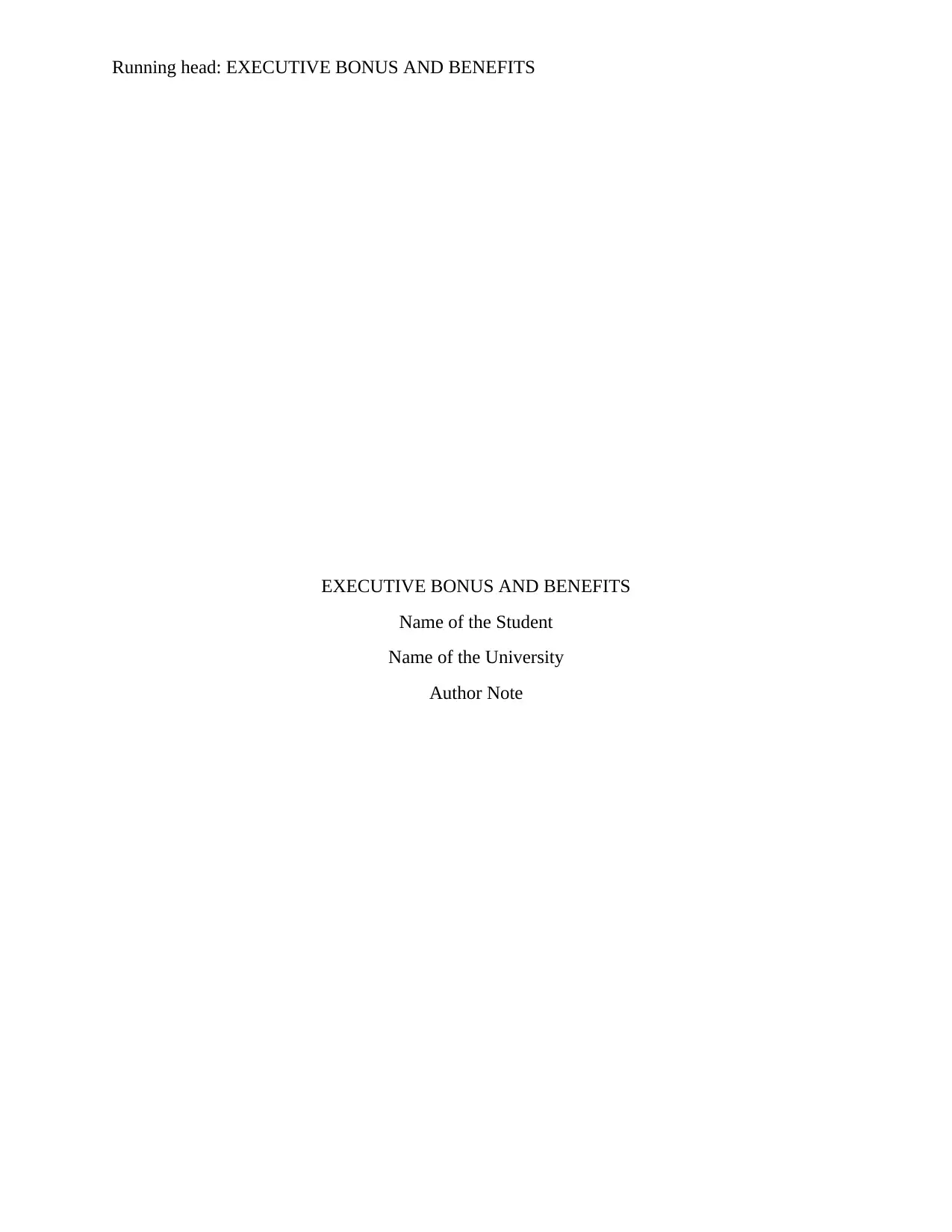
Running head: EXECUTIVE BONUS AND BENEFITS
EXECUTIVE BONUS AND BENEFITS
Name of the Student
Name of the University
Author Note
EXECUTIVE BONUS AND BENEFITS
Name of the Student
Name of the University
Author Note
Secure Best Marks with AI Grader
Need help grading? Try our AI Grader for instant feedback on your assignments.
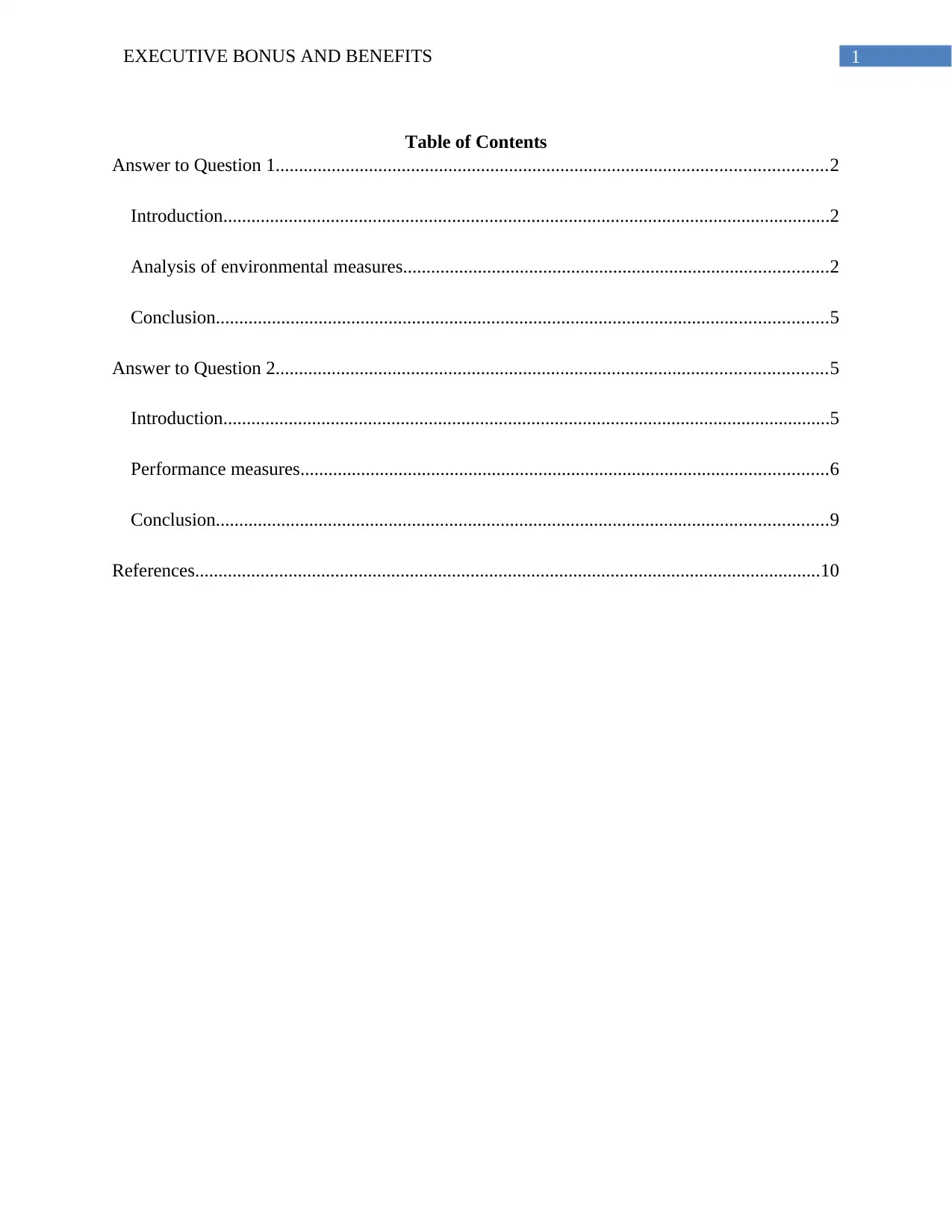
1EXECUTIVE BONUS AND BENEFITS
Table of Contents
Answer to Question 1......................................................................................................................2
Introduction..................................................................................................................................2
Analysis of environmental measures...........................................................................................2
Conclusion...................................................................................................................................5
Answer to Question 2......................................................................................................................5
Introduction..................................................................................................................................5
Performance measures.................................................................................................................6
Conclusion...................................................................................................................................9
References......................................................................................................................................10
Table of Contents
Answer to Question 1......................................................................................................................2
Introduction..................................................................................................................................2
Analysis of environmental measures...........................................................................................2
Conclusion...................................................................................................................................5
Answer to Question 2......................................................................................................................5
Introduction..................................................................................................................................5
Performance measures.................................................................................................................6
Conclusion...................................................................................................................................9
References......................................................................................................................................10
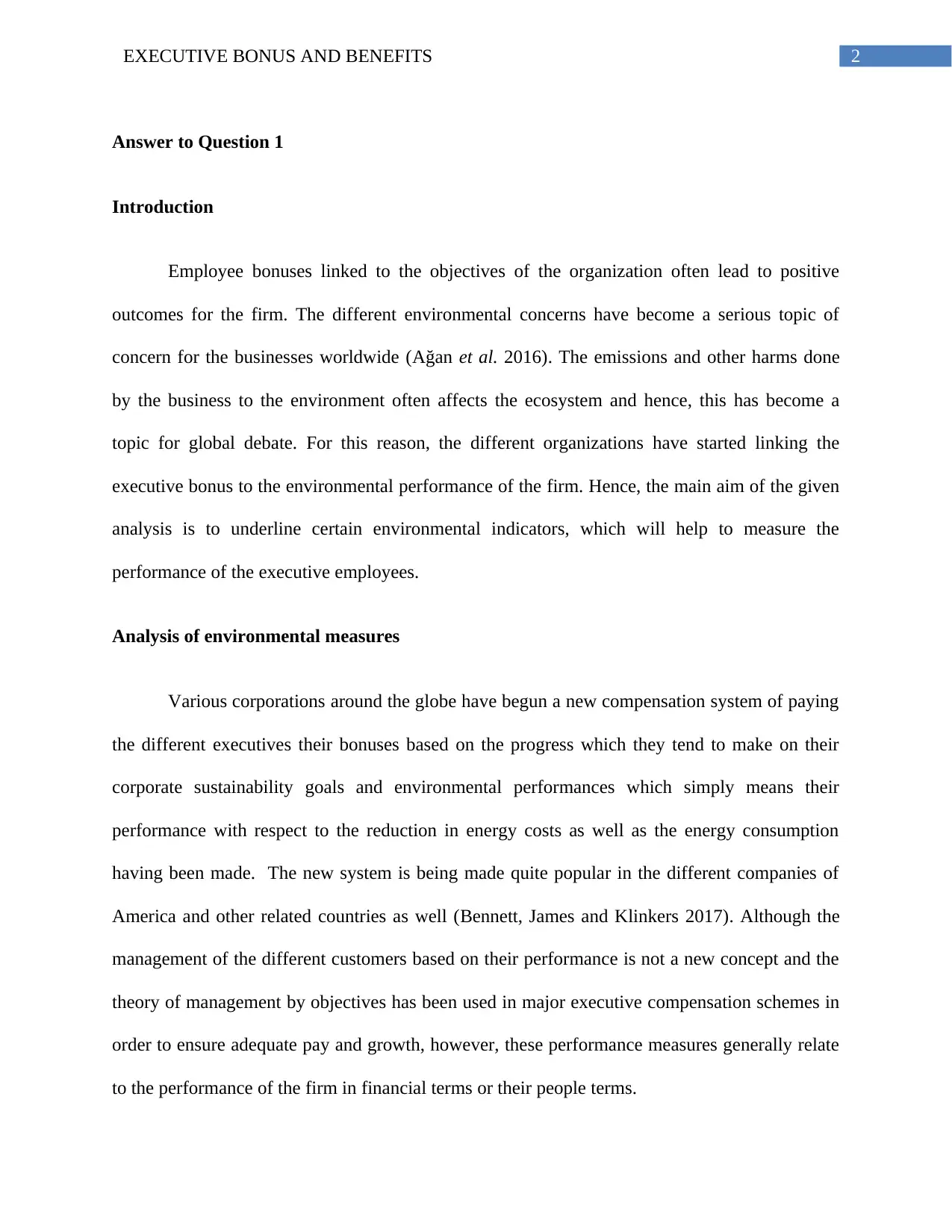
2EXECUTIVE BONUS AND BENEFITS
Answer to Question 1
Introduction
Employee bonuses linked to the objectives of the organization often lead to positive
outcomes for the firm. The different environmental concerns have become a serious topic of
concern for the businesses worldwide (Ağan et al. 2016). The emissions and other harms done
by the business to the environment often affects the ecosystem and hence, this has become a
topic for global debate. For this reason, the different organizations have started linking the
executive bonus to the environmental performance of the firm. Hence, the main aim of the given
analysis is to underline certain environmental indicators, which will help to measure the
performance of the executive employees.
Analysis of environmental measures
Various corporations around the globe have begun a new compensation system of paying
the different executives their bonuses based on the progress which they tend to make on their
corporate sustainability goals and environmental performances which simply means their
performance with respect to the reduction in energy costs as well as the energy consumption
having been made. The new system is being made quite popular in the different companies of
America and other related countries as well (Bennett, James and Klinkers 2017). Although the
management of the different customers based on their performance is not a new concept and the
theory of management by objectives has been used in major executive compensation schemes in
order to ensure adequate pay and growth, however, these performance measures generally relate
to the performance of the firm in financial terms or their people terms.
Answer to Question 1
Introduction
Employee bonuses linked to the objectives of the organization often lead to positive
outcomes for the firm. The different environmental concerns have become a serious topic of
concern for the businesses worldwide (Ağan et al. 2016). The emissions and other harms done
by the business to the environment often affects the ecosystem and hence, this has become a
topic for global debate. For this reason, the different organizations have started linking the
executive bonus to the environmental performance of the firm. Hence, the main aim of the given
analysis is to underline certain environmental indicators, which will help to measure the
performance of the executive employees.
Analysis of environmental measures
Various corporations around the globe have begun a new compensation system of paying
the different executives their bonuses based on the progress which they tend to make on their
corporate sustainability goals and environmental performances which simply means their
performance with respect to the reduction in energy costs as well as the energy consumption
having been made. The new system is being made quite popular in the different companies of
America and other related countries as well (Bennett, James and Klinkers 2017). Although the
management of the different customers based on their performance is not a new concept and the
theory of management by objectives has been used in major executive compensation schemes in
order to ensure adequate pay and growth, however, these performance measures generally relate
to the performance of the firm in financial terms or their people terms.
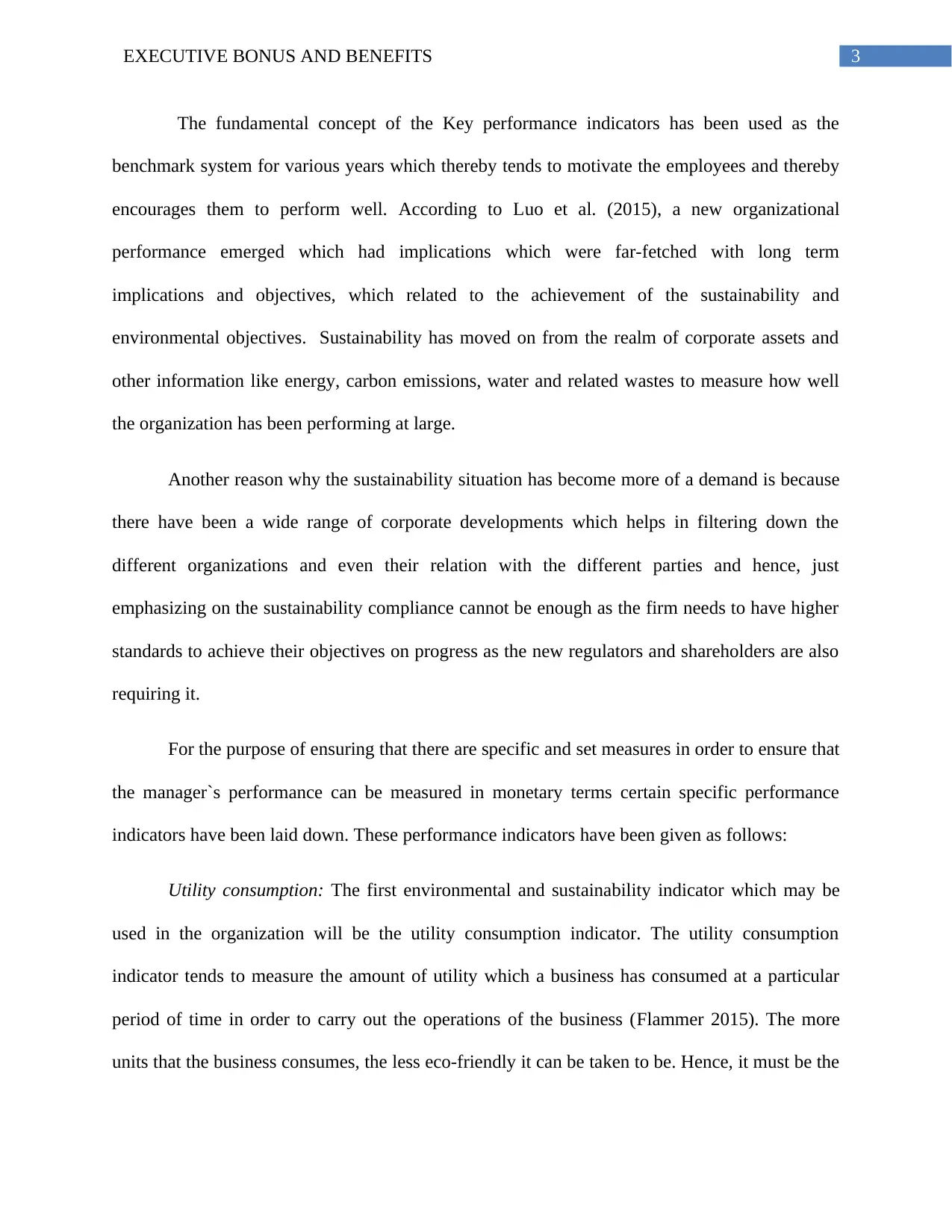
3EXECUTIVE BONUS AND BENEFITS
The fundamental concept of the Key performance indicators has been used as the
benchmark system for various years which thereby tends to motivate the employees and thereby
encourages them to perform well. According to Luo et al. (2015), a new organizational
performance emerged which had implications which were far-fetched with long term
implications and objectives, which related to the achievement of the sustainability and
environmental objectives. Sustainability has moved on from the realm of corporate assets and
other information like energy, carbon emissions, water and related wastes to measure how well
the organization has been performing at large.
Another reason why the sustainability situation has become more of a demand is because
there have been a wide range of corporate developments which helps in filtering down the
different organizations and even their relation with the different parties and hence, just
emphasizing on the sustainability compliance cannot be enough as the firm needs to have higher
standards to achieve their objectives on progress as the new regulators and shareholders are also
requiring it.
For the purpose of ensuring that there are specific and set measures in order to ensure that
the manager`s performance can be measured in monetary terms certain specific performance
indicators have been laid down. These performance indicators have been given as follows:
Utility consumption: The first environmental and sustainability indicator which may be
used in the organization will be the utility consumption indicator. The utility consumption
indicator tends to measure the amount of utility which a business has consumed at a particular
period of time in order to carry out the operations of the business (Flammer 2015). The more
units that the business consumes, the less eco-friendly it can be taken to be. Hence, it must be the
The fundamental concept of the Key performance indicators has been used as the
benchmark system for various years which thereby tends to motivate the employees and thereby
encourages them to perform well. According to Luo et al. (2015), a new organizational
performance emerged which had implications which were far-fetched with long term
implications and objectives, which related to the achievement of the sustainability and
environmental objectives. Sustainability has moved on from the realm of corporate assets and
other information like energy, carbon emissions, water and related wastes to measure how well
the organization has been performing at large.
Another reason why the sustainability situation has become more of a demand is because
there have been a wide range of corporate developments which helps in filtering down the
different organizations and even their relation with the different parties and hence, just
emphasizing on the sustainability compliance cannot be enough as the firm needs to have higher
standards to achieve their objectives on progress as the new regulators and shareholders are also
requiring it.
For the purpose of ensuring that there are specific and set measures in order to ensure that
the manager`s performance can be measured in monetary terms certain specific performance
indicators have been laid down. These performance indicators have been given as follows:
Utility consumption: The first environmental and sustainability indicator which may be
used in the organization will be the utility consumption indicator. The utility consumption
indicator tends to measure the amount of utility which a business has consumed at a particular
period of time in order to carry out the operations of the business (Flammer 2015). The more
units that the business consumes, the less eco-friendly it can be taken to be. Hence, it must be the
Secure Best Marks with AI Grader
Need help grading? Try our AI Grader for instant feedback on your assignments.
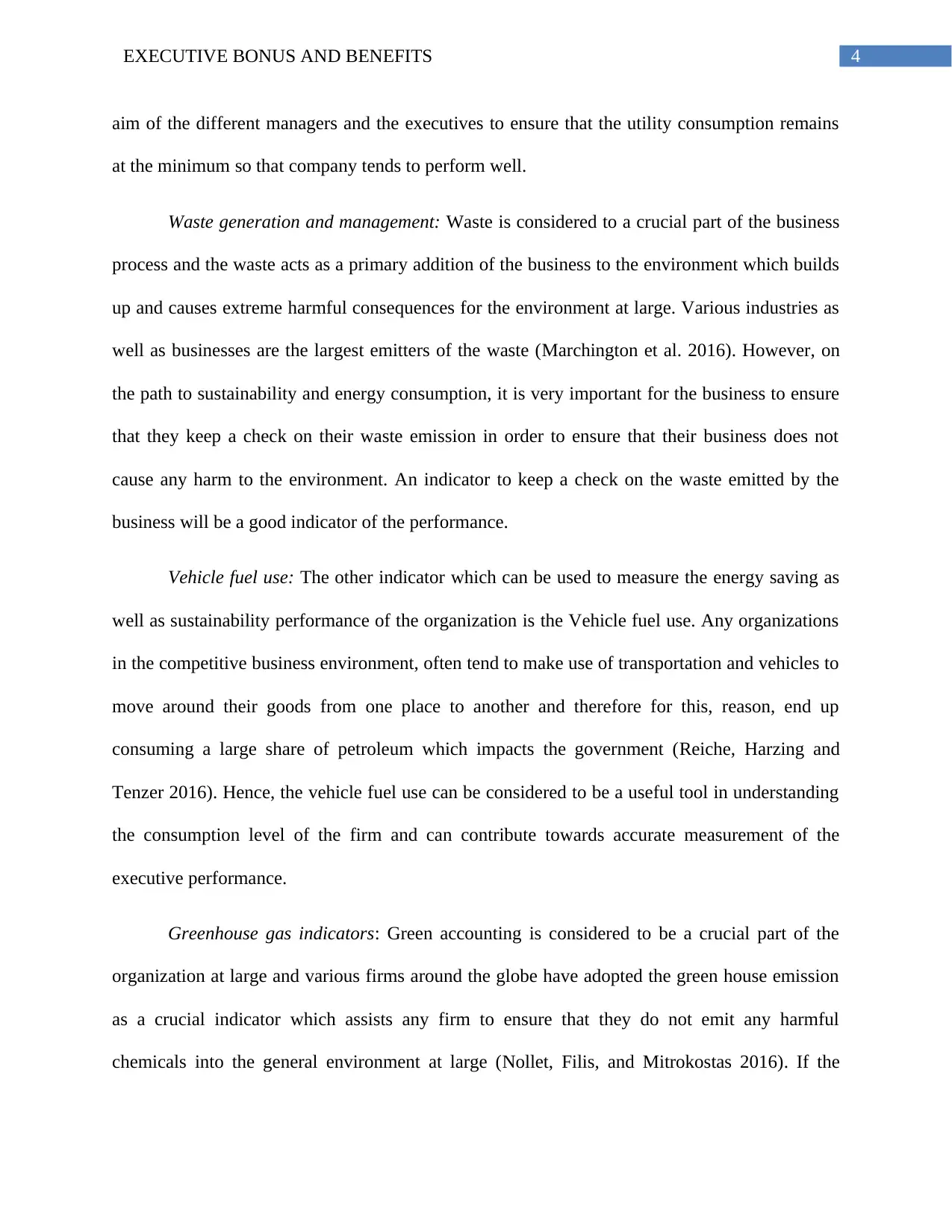
4EXECUTIVE BONUS AND BENEFITS
aim of the different managers and the executives to ensure that the utility consumption remains
at the minimum so that company tends to perform well.
Waste generation and management: Waste is considered to a crucial part of the business
process and the waste acts as a primary addition of the business to the environment which builds
up and causes extreme harmful consequences for the environment at large. Various industries as
well as businesses are the largest emitters of the waste (Marchington et al. 2016). However, on
the path to sustainability and energy consumption, it is very important for the business to ensure
that they keep a check on their waste emission in order to ensure that their business does not
cause any harm to the environment. An indicator to keep a check on the waste emitted by the
business will be a good indicator of the performance.
Vehicle fuel use: The other indicator which can be used to measure the energy saving as
well as sustainability performance of the organization is the Vehicle fuel use. Any organizations
in the competitive business environment, often tend to make use of transportation and vehicles to
move around their goods from one place to another and therefore for this, reason, end up
consuming a large share of petroleum which impacts the government (Reiche, Harzing and
Tenzer 2016). Hence, the vehicle fuel use can be considered to be a useful tool in understanding
the consumption level of the firm and can contribute towards accurate measurement of the
executive performance.
Greenhouse gas indicators: Green accounting is considered to be a crucial part of the
organization at large and various firms around the globe have adopted the green house emission
as a crucial indicator which assists any firm to ensure that they do not emit any harmful
chemicals into the general environment at large (Nollet, Filis, and Mitrokostas 2016). If the
aim of the different managers and the executives to ensure that the utility consumption remains
at the minimum so that company tends to perform well.
Waste generation and management: Waste is considered to a crucial part of the business
process and the waste acts as a primary addition of the business to the environment which builds
up and causes extreme harmful consequences for the environment at large. Various industries as
well as businesses are the largest emitters of the waste (Marchington et al. 2016). However, on
the path to sustainability and energy consumption, it is very important for the business to ensure
that they keep a check on their waste emission in order to ensure that their business does not
cause any harm to the environment. An indicator to keep a check on the waste emitted by the
business will be a good indicator of the performance.
Vehicle fuel use: The other indicator which can be used to measure the energy saving as
well as sustainability performance of the organization is the Vehicle fuel use. Any organizations
in the competitive business environment, often tend to make use of transportation and vehicles to
move around their goods from one place to another and therefore for this, reason, end up
consuming a large share of petroleum which impacts the government (Reiche, Harzing and
Tenzer 2016). Hence, the vehicle fuel use can be considered to be a useful tool in understanding
the consumption level of the firm and can contribute towards accurate measurement of the
executive performance.
Greenhouse gas indicators: Green accounting is considered to be a crucial part of the
organization at large and various firms around the globe have adopted the green house emission
as a crucial indicator which assists any firm to ensure that they do not emit any harmful
chemicals into the general environment at large (Nollet, Filis, and Mitrokostas 2016). If the
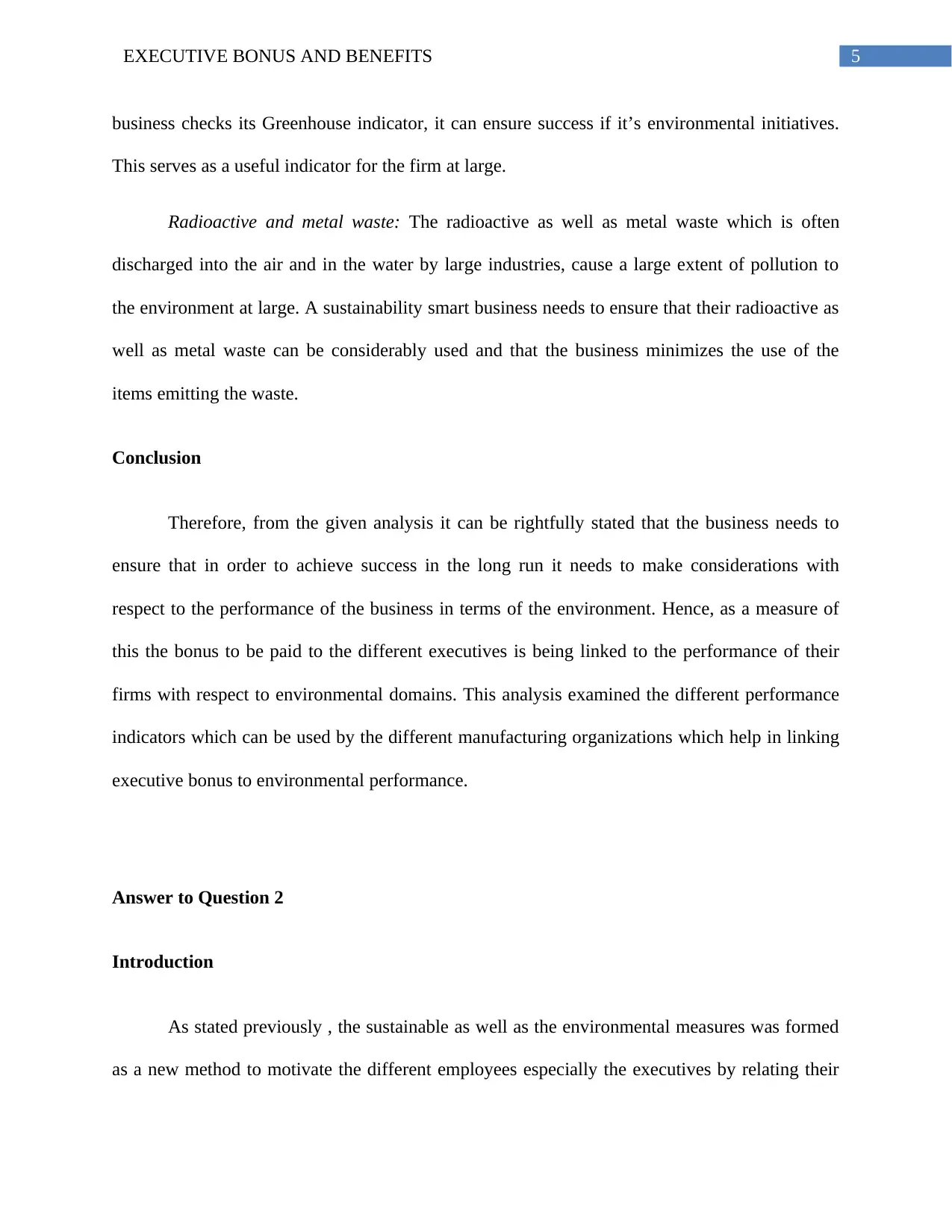
5EXECUTIVE BONUS AND BENEFITS
business checks its Greenhouse indicator, it can ensure success if it’s environmental initiatives.
This serves as a useful indicator for the firm at large.
Radioactive and metal waste: The radioactive as well as metal waste which is often
discharged into the air and in the water by large industries, cause a large extent of pollution to
the environment at large. A sustainability smart business needs to ensure that their radioactive as
well as metal waste can be considerably used and that the business minimizes the use of the
items emitting the waste.
Conclusion
Therefore, from the given analysis it can be rightfully stated that the business needs to
ensure that in order to achieve success in the long run it needs to make considerations with
respect to the performance of the business in terms of the environment. Hence, as a measure of
this the bonus to be paid to the different executives is being linked to the performance of their
firms with respect to environmental domains. This analysis examined the different performance
indicators which can be used by the different manufacturing organizations which help in linking
executive bonus to environmental performance.
Answer to Question 2
Introduction
As stated previously , the sustainable as well as the environmental measures was formed
as a new method to motivate the different employees especially the executives by relating their
business checks its Greenhouse indicator, it can ensure success if it’s environmental initiatives.
This serves as a useful indicator for the firm at large.
Radioactive and metal waste: The radioactive as well as metal waste which is often
discharged into the air and in the water by large industries, cause a large extent of pollution to
the environment at large. A sustainability smart business needs to ensure that their radioactive as
well as metal waste can be considerably used and that the business minimizes the use of the
items emitting the waste.
Conclusion
Therefore, from the given analysis it can be rightfully stated that the business needs to
ensure that in order to achieve success in the long run it needs to make considerations with
respect to the performance of the business in terms of the environment. Hence, as a measure of
this the bonus to be paid to the different executives is being linked to the performance of their
firms with respect to environmental domains. This analysis examined the different performance
indicators which can be used by the different manufacturing organizations which help in linking
executive bonus to environmental performance.
Answer to Question 2
Introduction
As stated previously , the sustainable as well as the environmental measures was formed
as a new method to motivate the different employees especially the executives by relating their
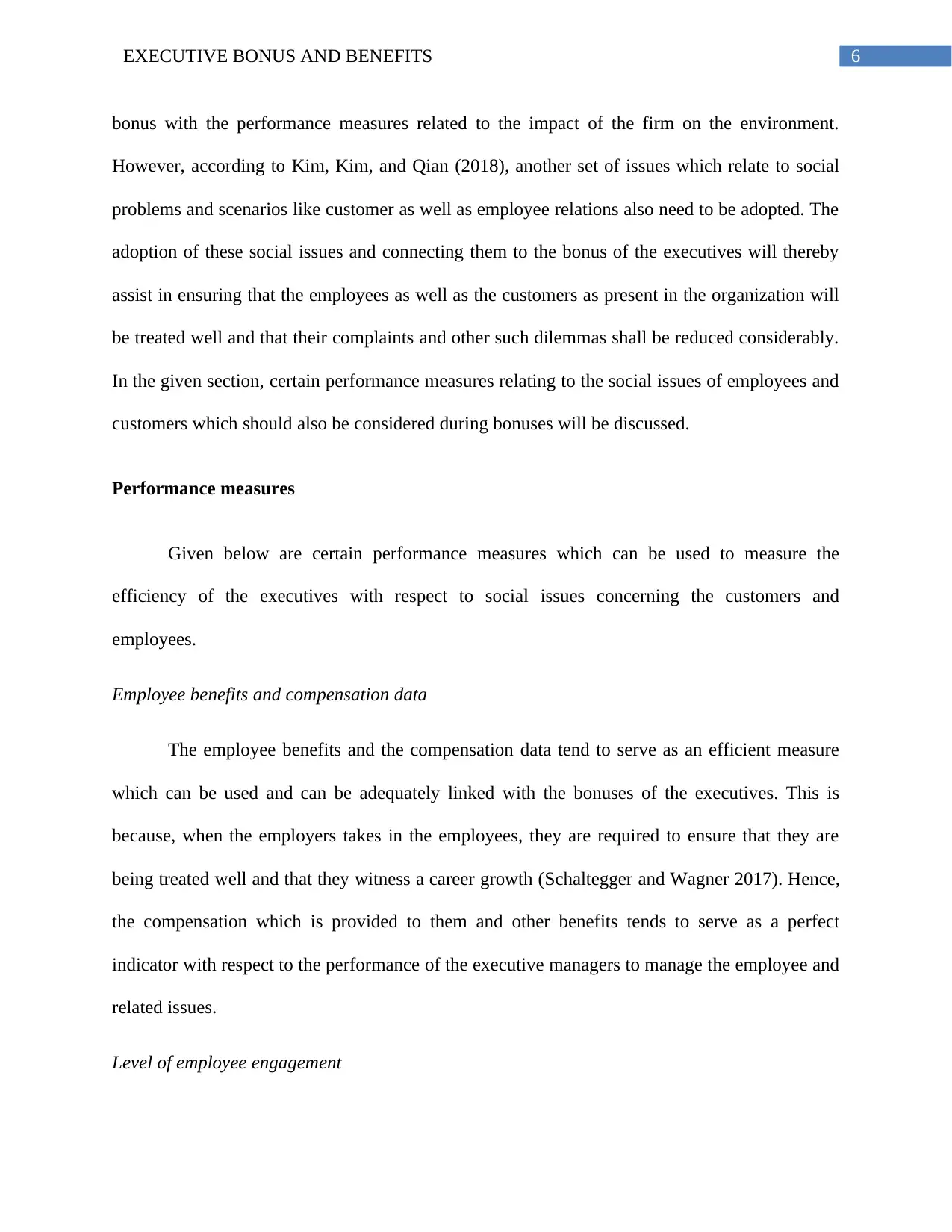
6EXECUTIVE BONUS AND BENEFITS
bonus with the performance measures related to the impact of the firm on the environment.
However, according to Kim, Kim, and Qian (2018), another set of issues which relate to social
problems and scenarios like customer as well as employee relations also need to be adopted. The
adoption of these social issues and connecting them to the bonus of the executives will thereby
assist in ensuring that the employees as well as the customers as present in the organization will
be treated well and that their complaints and other such dilemmas shall be reduced considerably.
In the given section, certain performance measures relating to the social issues of employees and
customers which should also be considered during bonuses will be discussed.
Performance measures
Given below are certain performance measures which can be used to measure the
efficiency of the executives with respect to social issues concerning the customers and
employees.
Employee benefits and compensation data
The employee benefits and the compensation data tend to serve as an efficient measure
which can be used and can be adequately linked with the bonuses of the executives. This is
because, when the employers takes in the employees, they are required to ensure that they are
being treated well and that they witness a career growth (Schaltegger and Wagner 2017). Hence,
the compensation which is provided to them and other benefits tends to serve as a perfect
indicator with respect to the performance of the executive managers to manage the employee and
related issues.
Level of employee engagement
bonus with the performance measures related to the impact of the firm on the environment.
However, according to Kim, Kim, and Qian (2018), another set of issues which relate to social
problems and scenarios like customer as well as employee relations also need to be adopted. The
adoption of these social issues and connecting them to the bonus of the executives will thereby
assist in ensuring that the employees as well as the customers as present in the organization will
be treated well and that their complaints and other such dilemmas shall be reduced considerably.
In the given section, certain performance measures relating to the social issues of employees and
customers which should also be considered during bonuses will be discussed.
Performance measures
Given below are certain performance measures which can be used to measure the
efficiency of the executives with respect to social issues concerning the customers and
employees.
Employee benefits and compensation data
The employee benefits and the compensation data tend to serve as an efficient measure
which can be used and can be adequately linked with the bonuses of the executives. This is
because, when the employers takes in the employees, they are required to ensure that they are
being treated well and that they witness a career growth (Schaltegger and Wagner 2017). Hence,
the compensation which is provided to them and other benefits tends to serve as a perfect
indicator with respect to the performance of the executive managers to manage the employee and
related issues.
Level of employee engagement
Paraphrase This Document
Need a fresh take? Get an instant paraphrase of this document with our AI Paraphraser
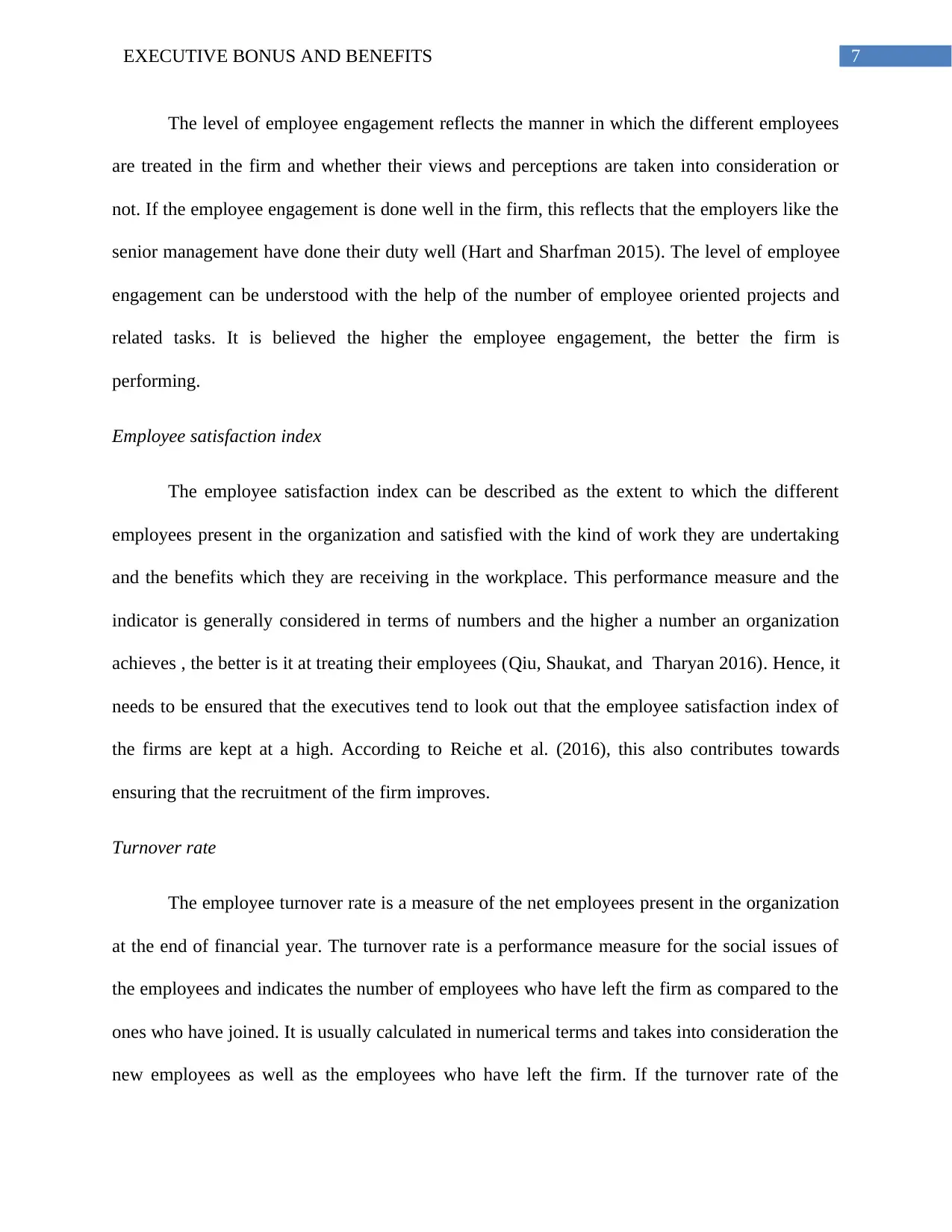
7EXECUTIVE BONUS AND BENEFITS
The level of employee engagement reflects the manner in which the different employees
are treated in the firm and whether their views and perceptions are taken into consideration or
not. If the employee engagement is done well in the firm, this reflects that the employers like the
senior management have done their duty well (Hart and Sharfman 2015). The level of employee
engagement can be understood with the help of the number of employee oriented projects and
related tasks. It is believed the higher the employee engagement, the better the firm is
performing.
Employee satisfaction index
The employee satisfaction index can be described as the extent to which the different
employees present in the organization and satisfied with the kind of work they are undertaking
and the benefits which they are receiving in the workplace. This performance measure and the
indicator is generally considered in terms of numbers and the higher a number an organization
achieves , the better is it at treating their employees (Qiu, Shaukat, and Tharyan 2016). Hence, it
needs to be ensured that the executives tend to look out that the employee satisfaction index of
the firms are kept at a high. According to Reiche et al. (2016), this also contributes towards
ensuring that the recruitment of the firm improves.
Turnover rate
The employee turnover rate is a measure of the net employees present in the organization
at the end of financial year. The turnover rate is a performance measure for the social issues of
the employees and indicates the number of employees who have left the firm as compared to the
ones who have joined. It is usually calculated in numerical terms and takes into consideration the
new employees as well as the employees who have left the firm. If the turnover rate of the
The level of employee engagement reflects the manner in which the different employees
are treated in the firm and whether their views and perceptions are taken into consideration or
not. If the employee engagement is done well in the firm, this reflects that the employers like the
senior management have done their duty well (Hart and Sharfman 2015). The level of employee
engagement can be understood with the help of the number of employee oriented projects and
related tasks. It is believed the higher the employee engagement, the better the firm is
performing.
Employee satisfaction index
The employee satisfaction index can be described as the extent to which the different
employees present in the organization and satisfied with the kind of work they are undertaking
and the benefits which they are receiving in the workplace. This performance measure and the
indicator is generally considered in terms of numbers and the higher a number an organization
achieves , the better is it at treating their employees (Qiu, Shaukat, and Tharyan 2016). Hence, it
needs to be ensured that the executives tend to look out that the employee satisfaction index of
the firms are kept at a high. According to Reiche et al. (2016), this also contributes towards
ensuring that the recruitment of the firm improves.
Turnover rate
The employee turnover rate is a measure of the net employees present in the organization
at the end of financial year. The turnover rate is a performance measure for the social issues of
the employees and indicates the number of employees who have left the firm as compared to the
ones who have joined. It is usually calculated in numerical terms and takes into consideration the
new employees as well as the employees who have left the firm. If the turnover rate of the
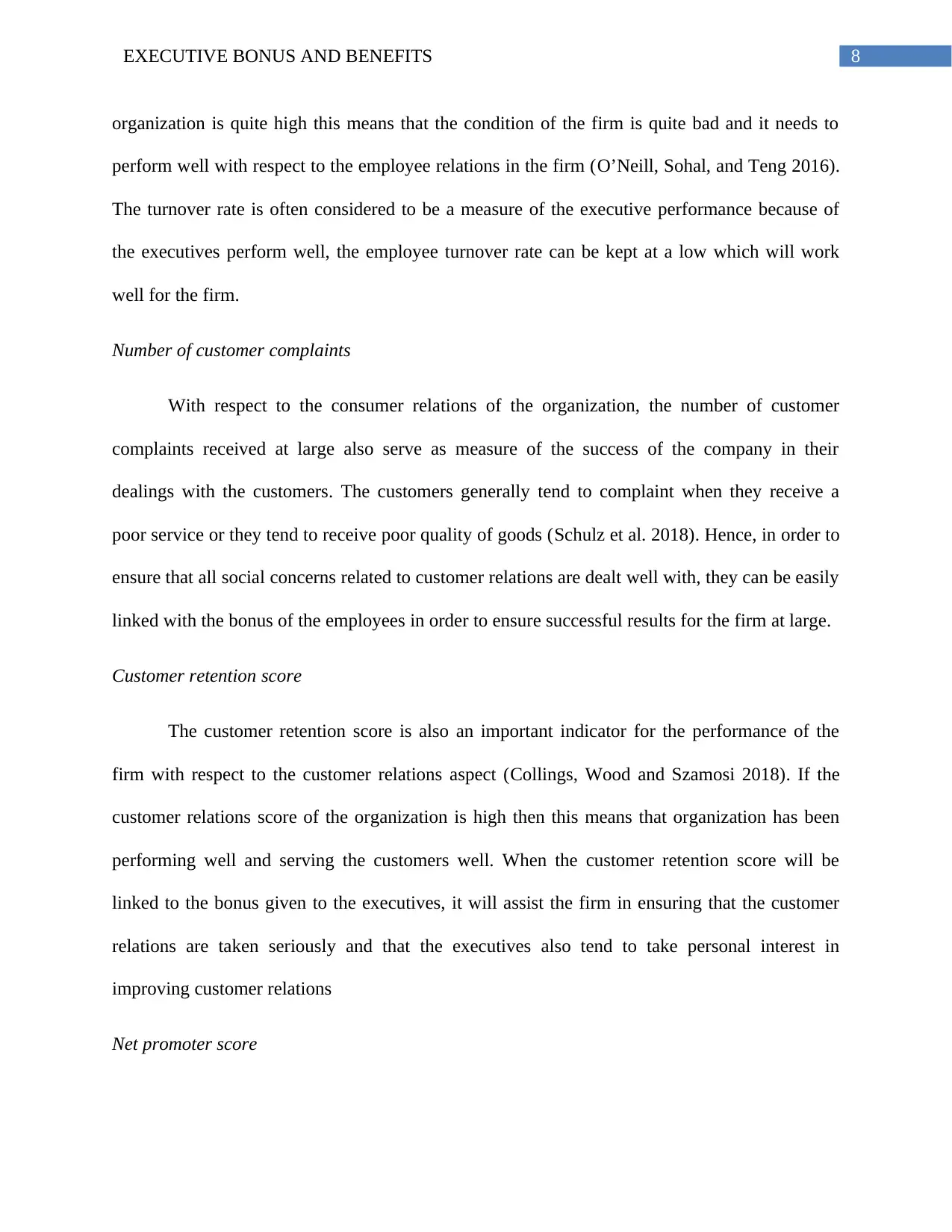
8EXECUTIVE BONUS AND BENEFITS
organization is quite high this means that the condition of the firm is quite bad and it needs to
perform well with respect to the employee relations in the firm (O’Neill, Sohal, and Teng 2016).
The turnover rate is often considered to be a measure of the executive performance because of
the executives perform well, the employee turnover rate can be kept at a low which will work
well for the firm.
Number of customer complaints
With respect to the consumer relations of the organization, the number of customer
complaints received at large also serve as measure of the success of the company in their
dealings with the customers. The customers generally tend to complaint when they receive a
poor service or they tend to receive poor quality of goods (Schulz et al. 2018). Hence, in order to
ensure that all social concerns related to customer relations are dealt well with, they can be easily
linked with the bonus of the employees in order to ensure successful results for the firm at large.
Customer retention score
The customer retention score is also an important indicator for the performance of the
firm with respect to the customer relations aspect (Collings, Wood and Szamosi 2018). If the
customer relations score of the organization is high then this means that organization has been
performing well and serving the customers well. When the customer retention score will be
linked to the bonus given to the executives, it will assist the firm in ensuring that the customer
relations are taken seriously and that the executives also tend to take personal interest in
improving customer relations
Net promoter score
organization is quite high this means that the condition of the firm is quite bad and it needs to
perform well with respect to the employee relations in the firm (O’Neill, Sohal, and Teng 2016).
The turnover rate is often considered to be a measure of the executive performance because of
the executives perform well, the employee turnover rate can be kept at a low which will work
well for the firm.
Number of customer complaints
With respect to the consumer relations of the organization, the number of customer
complaints received at large also serve as measure of the success of the company in their
dealings with the customers. The customers generally tend to complaint when they receive a
poor service or they tend to receive poor quality of goods (Schulz et al. 2018). Hence, in order to
ensure that all social concerns related to customer relations are dealt well with, they can be easily
linked with the bonus of the employees in order to ensure successful results for the firm at large.
Customer retention score
The customer retention score is also an important indicator for the performance of the
firm with respect to the customer relations aspect (Collings, Wood and Szamosi 2018). If the
customer relations score of the organization is high then this means that organization has been
performing well and serving the customers well. When the customer retention score will be
linked to the bonus given to the executives, it will assist the firm in ensuring that the customer
relations are taken seriously and that the executives also tend to take personal interest in
improving customer relations
Net promoter score
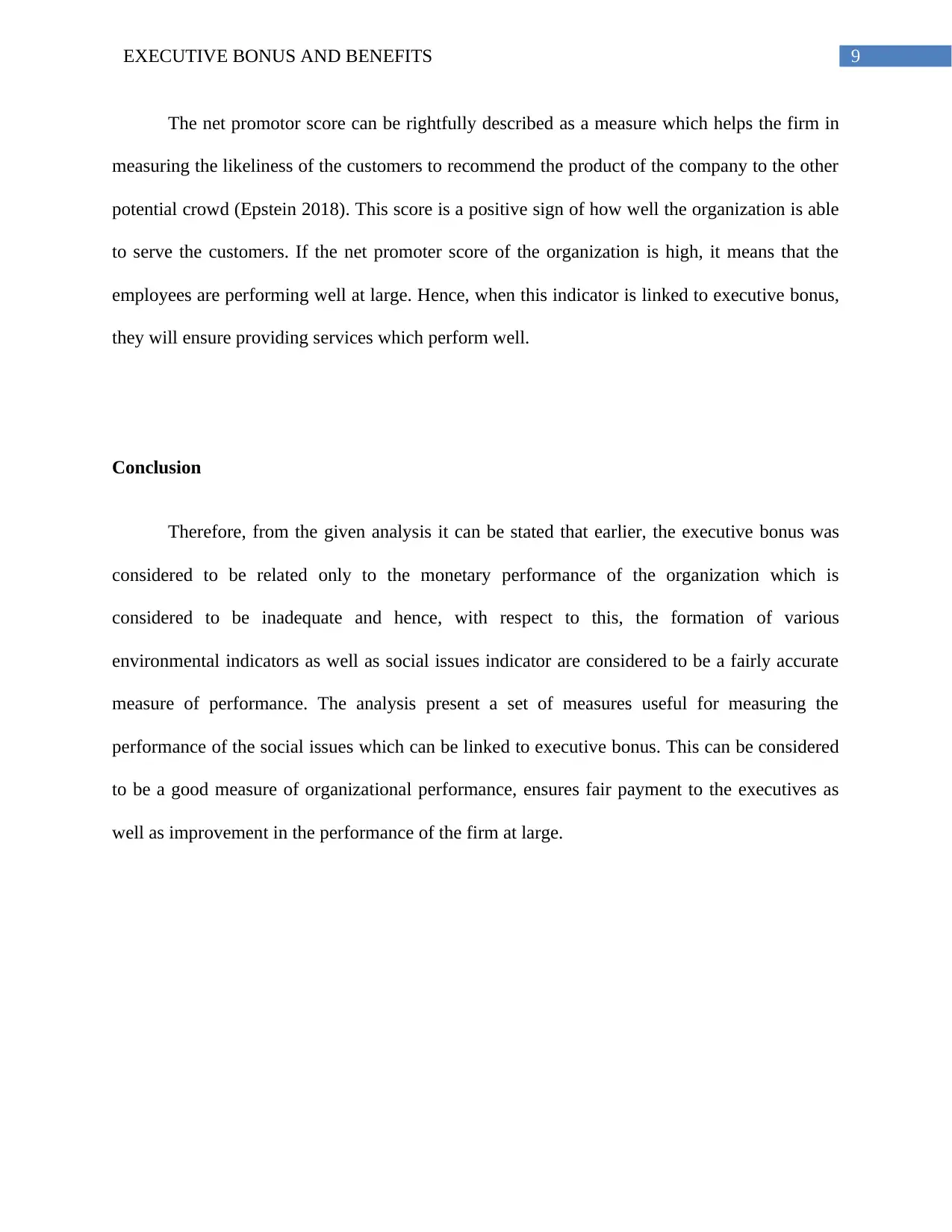
9EXECUTIVE BONUS AND BENEFITS
The net promotor score can be rightfully described as a measure which helps the firm in
measuring the likeliness of the customers to recommend the product of the company to the other
potential crowd (Epstein 2018). This score is a positive sign of how well the organization is able
to serve the customers. If the net promoter score of the organization is high, it means that the
employees are performing well at large. Hence, when this indicator is linked to executive bonus,
they will ensure providing services which perform well.
Conclusion
Therefore, from the given analysis it can be stated that earlier, the executive bonus was
considered to be related only to the monetary performance of the organization which is
considered to be inadequate and hence, with respect to this, the formation of various
environmental indicators as well as social issues indicator are considered to be a fairly accurate
measure of performance. The analysis present a set of measures useful for measuring the
performance of the social issues which can be linked to executive bonus. This can be considered
to be a good measure of organizational performance, ensures fair payment to the executives as
well as improvement in the performance of the firm at large.
The net promotor score can be rightfully described as a measure which helps the firm in
measuring the likeliness of the customers to recommend the product of the company to the other
potential crowd (Epstein 2018). This score is a positive sign of how well the organization is able
to serve the customers. If the net promoter score of the organization is high, it means that the
employees are performing well at large. Hence, when this indicator is linked to executive bonus,
they will ensure providing services which perform well.
Conclusion
Therefore, from the given analysis it can be stated that earlier, the executive bonus was
considered to be related only to the monetary performance of the organization which is
considered to be inadequate and hence, with respect to this, the formation of various
environmental indicators as well as social issues indicator are considered to be a fairly accurate
measure of performance. The analysis present a set of measures useful for measuring the
performance of the social issues which can be linked to executive bonus. This can be considered
to be a good measure of organizational performance, ensures fair payment to the executives as
well as improvement in the performance of the firm at large.
Secure Best Marks with AI Grader
Need help grading? Try our AI Grader for instant feedback on your assignments.
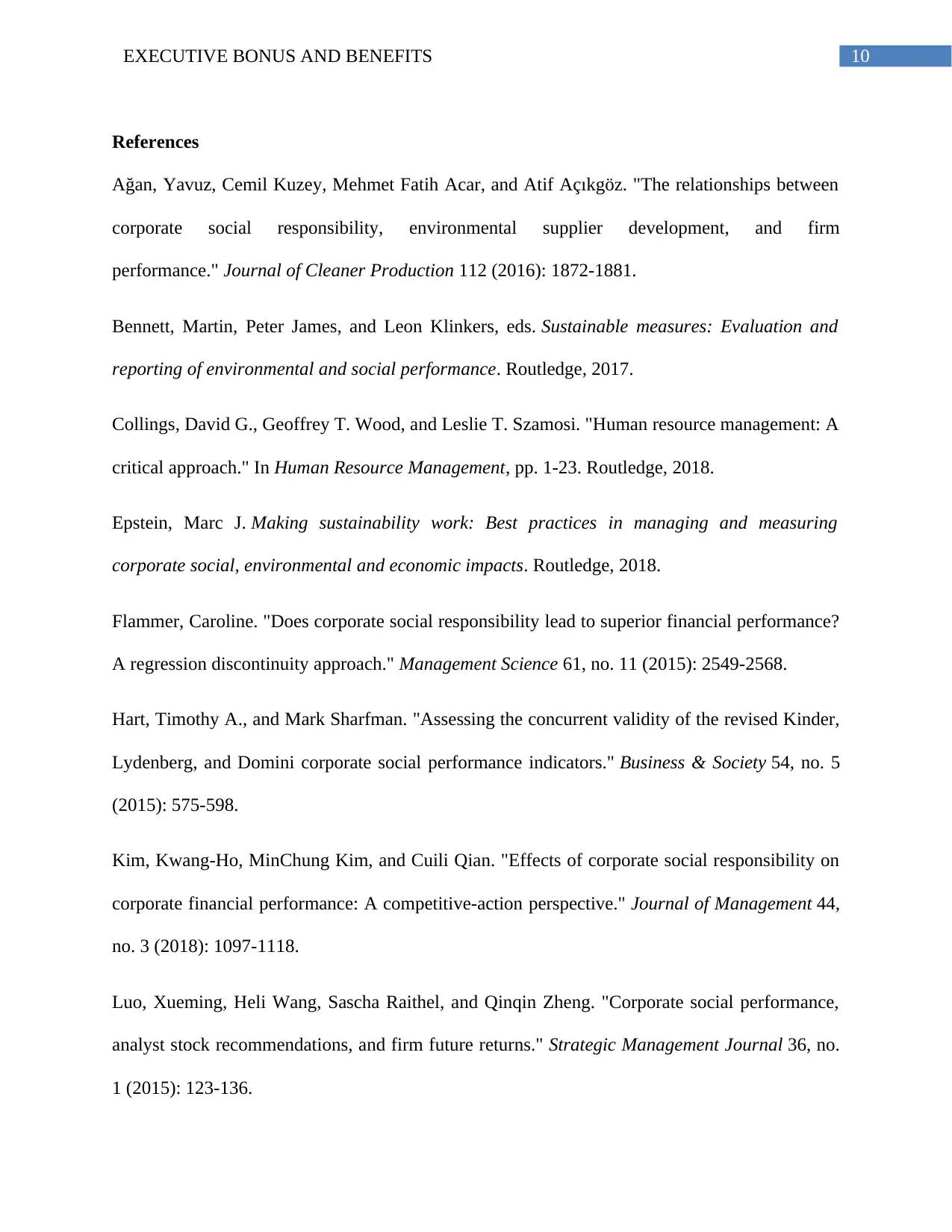
10EXECUTIVE BONUS AND BENEFITS
References
Ağan, Yavuz, Cemil Kuzey, Mehmet Fatih Acar, and Atif Açıkgöz. "The relationships between
corporate social responsibility, environmental supplier development, and firm
performance." Journal of Cleaner Production 112 (2016): 1872-1881.
Bennett, Martin, Peter James, and Leon Klinkers, eds. Sustainable measures: Evaluation and
reporting of environmental and social performance. Routledge, 2017.
Collings, David G., Geoffrey T. Wood, and Leslie T. Szamosi. "Human resource management: A
critical approach." In Human Resource Management, pp. 1-23. Routledge, 2018.
Epstein, Marc J. Making sustainability work: Best practices in managing and measuring
corporate social, environmental and economic impacts. Routledge, 2018.
Flammer, Caroline. "Does corporate social responsibility lead to superior financial performance?
A regression discontinuity approach." Management Science 61, no. 11 (2015): 2549-2568.
Hart, Timothy A., and Mark Sharfman. "Assessing the concurrent validity of the revised Kinder,
Lydenberg, and Domini corporate social performance indicators." Business & Society 54, no. 5
(2015): 575-598.
Kim, Kwang-Ho, MinChung Kim, and Cuili Qian. "Effects of corporate social responsibility on
corporate financial performance: A competitive-action perspective." Journal of Management 44,
no. 3 (2018): 1097-1118.
Luo, Xueming, Heli Wang, Sascha Raithel, and Qinqin Zheng. "Corporate social performance,
analyst stock recommendations, and firm future returns." Strategic Management Journal 36, no.
1 (2015): 123-136.
References
Ağan, Yavuz, Cemil Kuzey, Mehmet Fatih Acar, and Atif Açıkgöz. "The relationships between
corporate social responsibility, environmental supplier development, and firm
performance." Journal of Cleaner Production 112 (2016): 1872-1881.
Bennett, Martin, Peter James, and Leon Klinkers, eds. Sustainable measures: Evaluation and
reporting of environmental and social performance. Routledge, 2017.
Collings, David G., Geoffrey T. Wood, and Leslie T. Szamosi. "Human resource management: A
critical approach." In Human Resource Management, pp. 1-23. Routledge, 2018.
Epstein, Marc J. Making sustainability work: Best practices in managing and measuring
corporate social, environmental and economic impacts. Routledge, 2018.
Flammer, Caroline. "Does corporate social responsibility lead to superior financial performance?
A regression discontinuity approach." Management Science 61, no. 11 (2015): 2549-2568.
Hart, Timothy A., and Mark Sharfman. "Assessing the concurrent validity of the revised Kinder,
Lydenberg, and Domini corporate social performance indicators." Business & Society 54, no. 5
(2015): 575-598.
Kim, Kwang-Ho, MinChung Kim, and Cuili Qian. "Effects of corporate social responsibility on
corporate financial performance: A competitive-action perspective." Journal of Management 44,
no. 3 (2018): 1097-1118.
Luo, Xueming, Heli Wang, Sascha Raithel, and Qinqin Zheng. "Corporate social performance,
analyst stock recommendations, and firm future returns." Strategic Management Journal 36, no.
1 (2015): 123-136.
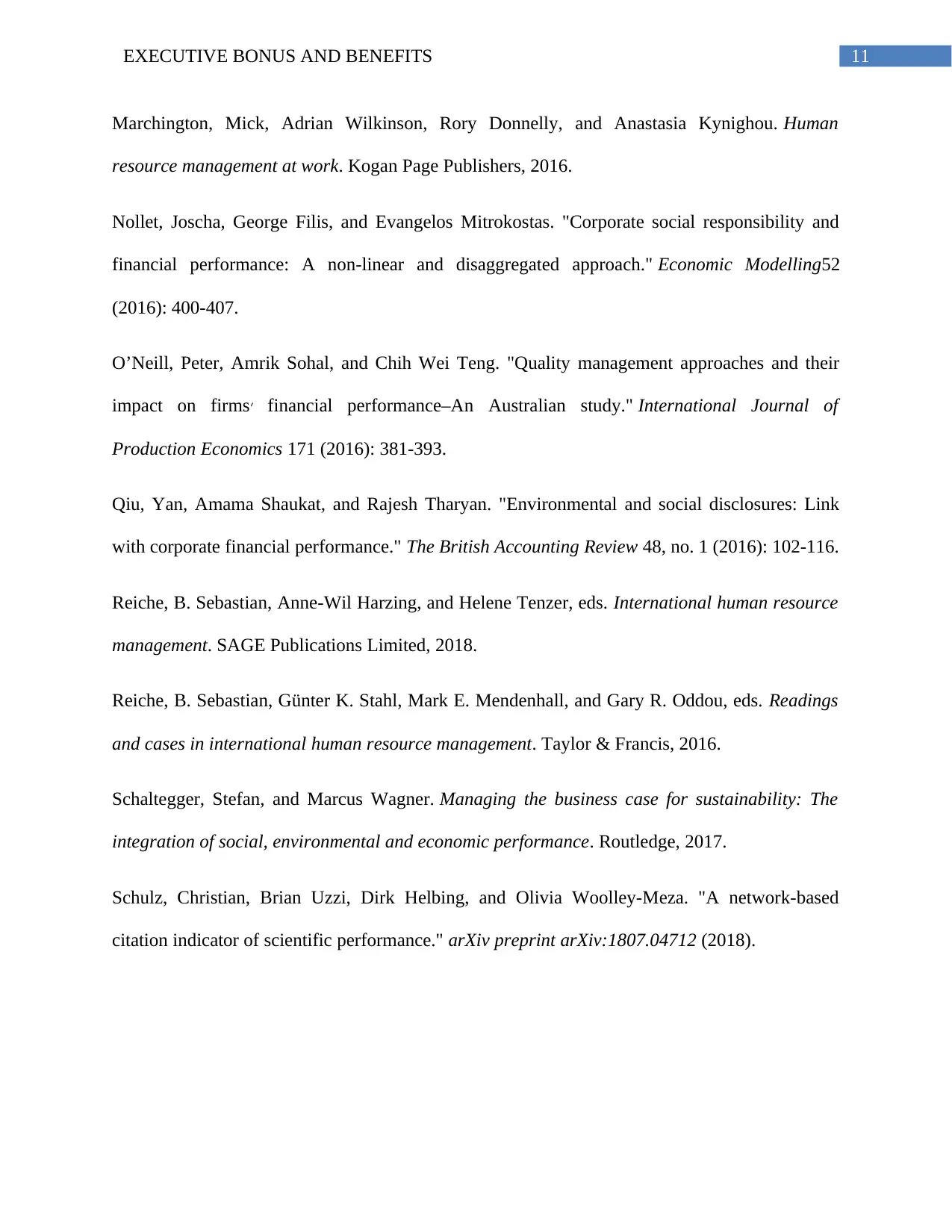
11EXECUTIVE BONUS AND BENEFITS
Marchington, Mick, Adrian Wilkinson, Rory Donnelly, and Anastasia Kynighou. Human
resource management at work. Kogan Page Publishers, 2016.
Nollet, Joscha, George Filis, and Evangelos Mitrokostas. "Corporate social responsibility and
financial performance: A non-linear and disaggregated approach." Economic Modelling52
(2016): 400-407.
O’Neill, Peter, Amrik Sohal, and Chih Wei Teng. "Quality management approaches and their
impact on firms׳ financial performance–An Australian study." International Journal of
Production Economics 171 (2016): 381-393.
Qiu, Yan, Amama Shaukat, and Rajesh Tharyan. "Environmental and social disclosures: Link
with corporate financial performance." The British Accounting Review 48, no. 1 (2016): 102-116.
Reiche, B. Sebastian, Anne-Wil Harzing, and Helene Tenzer, eds. International human resource
management. SAGE Publications Limited, 2018.
Reiche, B. Sebastian, Günter K. Stahl, Mark E. Mendenhall, and Gary R. Oddou, eds. Readings
and cases in international human resource management. Taylor & Francis, 2016.
Schaltegger, Stefan, and Marcus Wagner. Managing the business case for sustainability: The
integration of social, environmental and economic performance. Routledge, 2017.
Schulz, Christian, Brian Uzzi, Dirk Helbing, and Olivia Woolley-Meza. "A network-based
citation indicator of scientific performance." arXiv preprint arXiv:1807.04712 (2018).
Marchington, Mick, Adrian Wilkinson, Rory Donnelly, and Anastasia Kynighou. Human
resource management at work. Kogan Page Publishers, 2016.
Nollet, Joscha, George Filis, and Evangelos Mitrokostas. "Corporate social responsibility and
financial performance: A non-linear and disaggregated approach." Economic Modelling52
(2016): 400-407.
O’Neill, Peter, Amrik Sohal, and Chih Wei Teng. "Quality management approaches and their
impact on firms׳ financial performance–An Australian study." International Journal of
Production Economics 171 (2016): 381-393.
Qiu, Yan, Amama Shaukat, and Rajesh Tharyan. "Environmental and social disclosures: Link
with corporate financial performance." The British Accounting Review 48, no. 1 (2016): 102-116.
Reiche, B. Sebastian, Anne-Wil Harzing, and Helene Tenzer, eds. International human resource
management. SAGE Publications Limited, 2018.
Reiche, B. Sebastian, Günter K. Stahl, Mark E. Mendenhall, and Gary R. Oddou, eds. Readings
and cases in international human resource management. Taylor & Francis, 2016.
Schaltegger, Stefan, and Marcus Wagner. Managing the business case for sustainability: The
integration of social, environmental and economic performance. Routledge, 2017.
Schulz, Christian, Brian Uzzi, Dirk Helbing, and Olivia Woolley-Meza. "A network-based
citation indicator of scientific performance." arXiv preprint arXiv:1807.04712 (2018).
1 out of 12
Related Documents
Your All-in-One AI-Powered Toolkit for Academic Success.
+13062052269
info@desklib.com
Available 24*7 on WhatsApp / Email
![[object Object]](/_next/static/media/star-bottom.7253800d.svg)
Unlock your academic potential
© 2024 | Zucol Services PVT LTD | All rights reserved.





